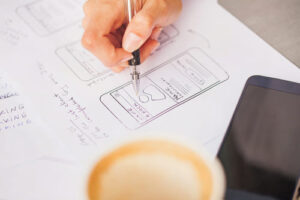UI and UX are often used interchangeably; however, while they have many similarities these two concepts are not the same. UI and UX are two unique elements of a single customer’s experience. Having a good UI/UX design can help maintain efficiency and create satisfactory usability results that allow for smooth interactions between consumers and products or services. Learn more about UI and UX and how they work together to improve the visible design of a web or mobile application.
What Is User Interface Design (UI)?
 UI stands for user interface design. User interface design refers to the design of user interfaces for software and machines, such as computers, mobile devices, home appliances, and other electronic devices. The main purpose of UI is to maximize the usability of these devices and to enhance user experience.
UI stands for user interface design. User interface design refers to the design of user interfaces for software and machines, such as computers, mobile devices, home appliances, and other electronic devices. The main purpose of UI is to maximize the usability of these devices and to enhance user experience.
User interfaces act as the access points in which users interact with designs. There are various components of UI, such as graphical user interfaces (GUIs) which are designs for control panels and faces.
Focuses On Facilitating & Guiding User Actions
User interface design focuses on anticipating what a user may need to do and creating elements within an interface that helps users access and facilitate these actions. Interface elements include several design elements, such as input controls like text fields, buttons, radio buttons, checkboxes, list boxes, data fields, dropdown lists, and list boxes.
Creation Of Navigational Components
UI also includes navigational components, such as sliders, icons, tags, breadcrumbs, search fields, and paginations. Another element of UI is informational components. This includes progress bars, message boxes, tooltips, and modal windows. Finally, UI elements include containers, such as an accordion. Oftentimes, more than one UI element is incorporated to effectively display content.
What Is User Experience Design (UX)?
 UX stands for user experience design. User experience design focuses on a consumer’s attitudes and emotions about using a particular product or service.
UX stands for user experience design. User experience design focuses on a consumer’s attitudes and emotions about using a particular product or service.
It also centers on the human-computer interaction and has experiential, practical, valuable, and meaningful aspects that can help businesses determine if certain products are relevant or meaningful to users.
Focus On Functionality Of Product To Entice Users
Design teams often use UX to create products that people are excited about using and that can deliver real value. UX can consist of a number of elements, such as the design, branding, function, and overall usability of a product. UX developers see products as more than just a product but as an experience.
Design Which Aligns With Business Goals & Objectives
User experience design is all about how a person feels when they are interfacing with a system. When referring to systems, this can mean a web application, website, desktop software, or some other form of human-computer interaction. While the main aim of UX is to gain a deeper understanding of users, their abilities, their limitations, and what they value, these are not the only benefits that UX can provide to businesses.
UX design can also be implemented in a way that aligns with business goals and objectives. To create a valuable user experience, information must be useful, desirable, usable, accessible, findable, and credible.
How Are UI/UX Different?
 UI and UX are often confused and misused. While these two concepts do go hand-in-hand, they involve separate processes and tasks. The main difference between the user interface and user experience and that UX design puts a focus on the overall feel of an experience while UI design is more about how the product’s interfaces function and look.
UI and UX are often confused and misused. While these two concepts do go hand-in-hand, they involve separate processes and tasks. The main difference between the user interface and user experience and that UX design puts a focus on the overall feel of an experience while UI design is more about how the product’s interfaces function and look.
In addition, UX typically comes first in the product development process and UI comes after to complete the interactive and visual elements. Another difference is that UX generally applies to any type of product or service, while UI focuses primarily on digital products.
The Benefits Of UI/UX
When choosing a custom software development partner, experience and expertise with UI/UX can provide businesses with numerous benefits, including a great return on investment. Successful user experience and design can give companies a competitive advantage.
Increased Customer Retention
Creating a well-made application can also result in customer retention. When you offer something that people want, people will continue using it. As competition continues to grow in a competitive marketplace, customer retention is paramount.
Lower Operational Costs
Developing a well-designed app can also result in lower support costs. When you offer an application that does not require increased training or support, there are naturally fewer costs involved. UI/UX allows you to expect a reduction in development time eliminating time wasted fixing errors or redoing work.
Speak With A Professional Custom Software Development Company
It has become increasingly challenging for businesses to catch and retain the attention of consumers. Having an excellent user interface and experience design strategy can be instrumental to the long-term success of your company. If you have invested in marketing to drive traffic to your products or services, you want to ensure that you are providing the best product and user experience possible.
For more information about UI/UX or custom software development, speak to the developers at Orases today by calling 301.756.5527 or by requesting a consultation online.






